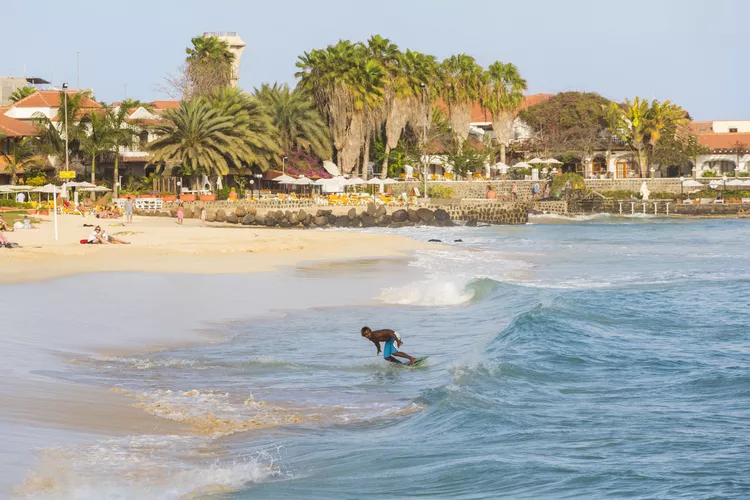The Cape Verde Islands (known locally as Cabo Verde, the “Green Cape”) lie just off the coast of Senegal in West Africa. Cape Verde is famous for its warm tropical climate, volcanic islands, wonderful musicians, and delicious cuisine. Although many Americans may not be familiar with Cape Verde, Europeans often regard these islands as an ideal winter getaway.
Basic Facts
The Cape Verde islands form an archipelago of ten islands and five islets located about 500 km off the West African coast. Collectively, Cape Verde covers an area of 4,033 square kilometers (1,557 square miles). The Portuguese settled these uninhabited islands in the 15th Century to establish a slave post. The population comprises a blend of Portuguese and African descent, with most people speaking Crioulo, which is a mix of Portuguese and West African languages. Portuguese serves as the official language of government. The capital and largest city, Sal, is located on the biggest island, Santiago.
Mid-20th Century droughts and some volcanic activity resulted in over 200,000 fatalities, prompting many inhabitants to migrate away. Currently, there are more Cape Verdeans residing abroad than on the islands themselves, with the population hovering around 500,000.
Best Time to Go
Cape Verde enjoys a steady tropical climate year-round, generally cooler than much of West Africa. Average daytime temperatures typically range from about 20 to 28 degrees Celsius (70 to 85 degrees Fahrenheit), peaking from May to November. This climate allows for hiking and swimming activities throughout the year, although nights can be chilly from December through March. Additionally, the harmattan winds, bringing hot air and Saharan sands, can affect half the archipelago from November through March, with the majority of rainfall occurring between late August and early October.
The period around February, particularly the carnival in Mindelo on São Vicente island, is especially vibrant. The peak tourist season runs from November to April, attracting numerous Europeans looking for a winter escape.
Where to Go
Cape Verde is a highly sought-after destination for travelers seeking a relaxing, sun-filled holiday. For those who prefer exploring remote islands off the beaten path rather than staying in resorts, some effort will be needed to discover these hidden gems. Cape Verde boasts a low crime rate, amiable locals, and great seafood. The tap water is safe to drink, and medical facilities on main islands are reasonable, making it an attractive destination for visitors. Key highlights include:
- Santa Maria – This developed area is a favorite for beach lovers, with many charter flights landing directly in Sal Island. Although Santa Maria offers exceptional watersports and beaches, there are additional islands worth visiting for those seeking greenery and hiking opportunities.
- Santiago – Cape Verde’s largest island features the capital city Praia, which can be bustling and overwhelming for first-time African travelers. Here, you will find a lively vegetable market and rich history linked to pirates and Charles Darwin, along with beautiful beaches in Tarrafal and the historic UNESCO site of Cidade Velha, just 15km from Praia.
- Boa Vista – Home to Santa Monica beach—one of the country’s best—Boa Vista is a must-visit for sun-seekers. The island’s volcanic interior is also captivating, with 4×4 quad biking opportunities abounding.
What to See and Do
- Music – Cape Verde’s renowned musician and cultural ambassador, Cesaria Evora, may have passed away in 2011, but her legacy remains. Traditional music genres such as morna and coladeira can be heard across the islands. Mindelo, the cultural heart on São Vicente island, is particularly prominent for its musical scene and carnival festivities occurring every February.
- Hiking – Mount Fogo, an active volcano on Fogo Island and the highest peak in the archipelago, is a prime destination for trekkers. Santo Antão island also offers stunning scenery with charming cobbled paths amid volcanic peaks and lush tropical forests, perfect for authentic bed-and-breakfast stays in small villages.
- Watersports – Activities like fishing, diving, and surfing are readily accessible on the islands. Santiago island serves as the central hub for tourists, making it easy to arrange activities through various local operators. The consistent winds also make Cape Verde appealing for windsurfing and kite surfing enthusiasts.
How to Get There
For travelers seeking the best deals to Cape Verde, consider consulting tour operators specializing in the region. A direct flight from Boston to Sal is available once a week via Cape Verde’s national airline (TACV), serving the substantial local Cape Verdean community. TACV also provides regular flights to and from major cities such as Amsterdam, Madrid, Lisbon, and Milan.
Getting Around
To navigate each island, taxis are widely available, with shared taxis offering the most economical option as they follow set routes. For island-hopping, ferries and small aircraft are the most efficient means of transport. However, be aware that ferries can sometimes run late, so travelers should remain flexible as some journeys may take several hours. TACV operates scheduled flights connecting all major islands.





